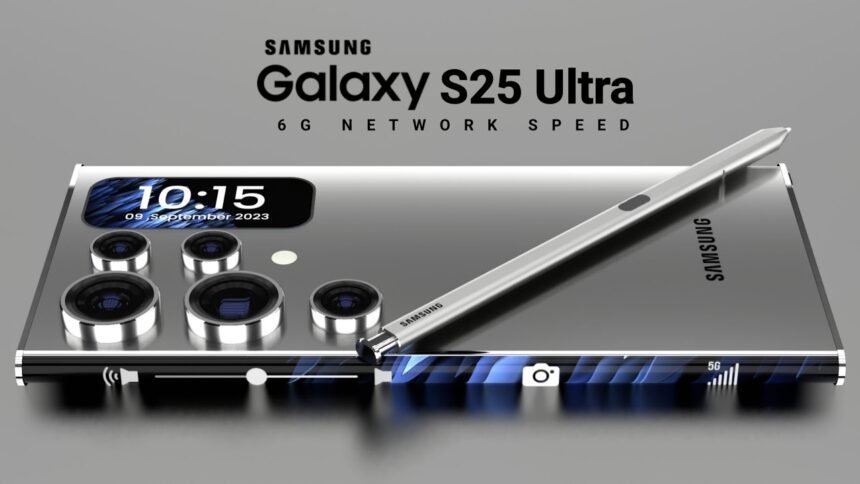Samsung Galaxy S25 Ultra 12/256GB: Samsung is set to unveil the all-new Samsung Galaxy S25 Ultra in January 2025, and the excitement is already building. As a leading tech brand used by millions worldwide, Samsung always sparks curiosity with its new releases, and the rumored features of the S25 Ultra are no exception.

Early rumors suggest that the S25 Ultra might come with a more powerful processor than its predecessor, possibly surpassing the Snapdragon 8. Fans are eagerly anticipating what other innovative features Samsung has in store for its latest flagship model. Stay tuned for more updates as the launch date approaches.
The Exynos 2500 was supposed to be Samsung’s gateway towards reducing its dependency on Qualcomm. Initially, the company was reported to adopt a dual-chipset launch strategy for the Galaxy S25 series. This strategy involved using both its own Exynos 2500 chipset and Qualcomm’s Snapdragon 8 Gen 4, thereby diversifying its supply chain and potentially optimizing performance across different markets. Unfortunately, not all plans can come to fruition, as an analyst now states that the Snapdragon 8 Gen 4 might exclusively be used in Samsung’s 2025 flagship series. This change is attributed to poor 3nm yields that might prevent the Exynos 2500 from shipping on time.
Samsung Galaxy S25 Ultra Flagship Prices
As Qualcomm raises prices on its flagship chipsets, Samsung struggles to maintain profit margins. The Snapdragon 8 Gen 4 is expected to be pricier than the Snapdragon 8 Gen 3, forcing Samsung to make compromises to offset costs.
MediaTek’s Dimensity 9400, using the same TSMC 3nm ‘N3E’ process, offers comparable performance and efficiency. MediaTek’s chipsets are more affordable, with Q1 2024 data showing they shipped 114 million units for $23 billion, while Qualcomm shipped 75 million units for $37 billion.
This pricing advantage gives MediaTek a chance to prove its premium SoC can match or exceed Qualcomm’s. If successful, Samsung could form a long-term partnership with MediaTek, maintaining profit margins and delivering high-performance smartphones without relying solely on Qualcomm.
Samsung Galaxy S25 Ultra Technology
Samsung has faced multiple reports of adopting a dual-chipset launch strategy when unveiling the Galaxy S25 lineup. However, as usual, the company has encountered 3nm yield problems. These yield issues mean that the Exynos 2500 might not be ready for mass production in time for the Galaxy S25 launch. The complexity and challenges associated with the advanced 3nm process technology have significantly impacted Samsung’s production timelines, delaying the anticipated integration of its homegrown chipset.
Despite these setbacks, there is a glimmer of hope for Samsung’s dual-chipset strategy. The South Korean publication The Financial News has commented on the possibility of using a MediaTek chipset as an alternative. This consideration rekindles Samsung’s dream of maintaining its dual-chipset launch strategy for the Galaxy S25 series. The rationale behind testing the Galaxy S25 with a MediaTek chipset is sound. MediaTek has made significant strides in recent years, producing competitive and efficient chipsets that rival those of Qualcomm. By incorporating MediaTek chipsets, Samsung can mitigate the risk associated with 3nm yield problems while still achieving its goal of diversifying its chipset supply.

Using MediaTek as a contingency plan could provide several advantages for Samsung. Firstly, it allows the company to reduce its reliance on Qualcomm, which has been a strategic objective for some time. Samsung Galaxy S25 Ultra 12/256GB diversifying chipset suppliers can also lead to better negotiation leverage, potentially resulting in cost savings and more favorable terms for Samsung. Additionally, MediaTek’s recent advancements in chip technology mean that Samsung can still offer a high-performance device without solely relying on Qualcomm or its own Exynos chips.
Furthermore, the adoption of a MediaTek chipset might also appeal to certain markets where MediaTek has a strong presence. This could enhance Samsung’s market penetration and cater to a broader audience, further solidifying its position in the global smartphone market.
However, there are challenges to this approach. Integrating a new chipset supplier into the production process requires extensive testing and validation to ensure compatibility and performance standards are met. Any delay or issue in this phase could impact the overall launch timeline of the Samsung Galaxy S25 Ultra 12/256GB series. Moreover, consumer perception and brand loyalty towards specific chipsets, such as Qualcomm’s Snapdragon, might influence market reception.
In conclusion, while the Exynos 2500 was initially envisioned as a crucial component in Samsung’s strategy to reduce dependency on Qualcomm, unforeseen challenges with 3nm yields have necessitated a shift in plans. The potential use of a MediaTek chipset offers a viable alternative, enabling Samsung to maintain its dual-chipset launch strategy for the Galaxy S25 series. This strategic move not only helps mitigate risk but also aligns with Samsung’s broader objective of diversifying its supply chain and optimizing performance across different markets. Despite the inherent challenges, this approach underscores Samsung’s adaptability and commitment to delivering cutting-edge technology to its consumers.
Read More:
- Apple Confirms iOS 18 Beta 2 Release with Two Major Features Arriving June 24; Apple Intelligence Limited to Newest Devices, EU Release Delayed
- Apple iPhone 16 Pro Max: Price, Features, Release Date
- Samsung Galaxy S25 Ultra: Exciting Innovations and Strategic Shifts in Chipset Choices Amid Qualcomm’s Price Hikes, Exynos 2500 Production Delays, and MediaTek’s Emerging Role in 2025 Flagship Series
- Apple iPhone 16 Pro vs iPhone 16 Pro Max : Price, Features, Release Date and Rumoured Variations Between the Two Pro Models














